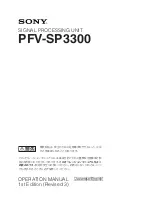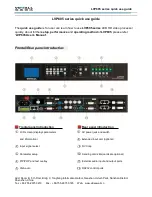
29
EN
IT
DPX4080
4.10 Tmax Thermal Limiter
The Thermal Limiter is intended to protect the driver
against damage due to over-heating. It models the
temperature of the driver, and constrains the out-
put signal level in order to keep the average output
power below a predetermined limit, applying attack
and release characteristics to go some way towards
modelling the complex thermal circuit of a driver’s
voice coil and magnet assembly.
Three parameters are available for adjustment:
Threshold – the continuous RMS voltage which the
driver should be able to withstand. This is calibrated
at the output of the amplifier. The Thermal Limiter
can be defeated by setting the Threshold to the max-
imum “Off” value.
Attack – The time-constant of the speed at which the
driver heats up (in seconds).
Release – The time-constant of the speed at which
the driver cools down (expressed as a multiple of the
Attack time).
4.11 Xmax Excursion Limiter
The Excursion Limiter protects the driver against ex-
cessive linear movement of the cone and voice-coil
which could otherwise cause mechanical damage.
Since this movement (excursion) is largely related to
the inverse of the signal frequency, drivers are prone
to being damaged by very low frequencies. This lim-
iter is progressively more sensitive at lower frequen-
cies and, rather than varying the gain to provide the
limiting action, it uses a sliding high-pass filter to
progressively curtail the low-frequency response.
To set the limiter up, it is necessary to know the shape
of the family of Excursion vs. Frequency curves of the
driver for various drive voltage levels. A curve should
then be chosen where the slope is high where it
passes though the specified X-Max value for the
driver. The peak voltage and frequency of this point
should then be noted.
The Xmax limiter is usually then set up using just two
parameters:
Threshold – the peak voltage of the point arrived at
above. This is calibrated at the output of the ampli-
fier. The Excursion Limiter can be defeated by setting
Threshold to the maximum “Off” value.
Frequency – The frequency at which the above
threshold voltage is appropriate.
A further parameter “Min” may also be available for
more advanced applications. This allows the increas-
ing limiting action at lower frequencies to level-off
dalità non VX, questo ritardo dipenderà dalla fre-
quenza passa-alto più bassa utilizzata nei filtri cros-
sover in un determinato modulo di azionamento.
In modalità VX, il ritardo è correlato alla frequenza
di split. Questo ritardo verrà applicato a tutte le
uscite di un determinato modulo di azionamento
per mantenerle in fase. Vedi anche Latency Delays.
4.10 Tmax Thermal Limiter
Il Thermal Limiter ha lo scopo di proteggere il dri-
ver da danni dovuti a surriscaldamento. Modella la
temperatura del driver e limita il livello del segnale
di uscita al fine di mantenere la potenza di uscita
media al di sotto di un limite prestabilito, applican-
do le caratteristiche di attacco e rilascio per andare
in qualche modo a modellare il complesso circuito
termico della bobina di un driver e del gruppo ma-
gnete.
Sono disponibili tre parametri per la regolazione:
Soglia: la tensione RMS continua a cui il driver do-
vrebbe essere in grado di resistere. Questo è cali-
brato all’uscita dell’amplificatore. Il limitatore ter-
mico può essere disattivato impostando la soglia
sul valore massimo di “Off”.
Attack - La costante di tempo della velocità alla
quale il driver si riscalda (in secondi).
Rilascio: la costante di tempo della velocità alla
quale il driver si raffredda (espressa come multiplo
del tempo di attacco).
4.11 Xmax Excursion Limiter
Excursion Limiter protegge il driver dall’eccessivo
movimento lineare del cono e della bobina che
potrebbero altrimenti causare danni meccanici.
Poiché questo movimento (escursione) è in gran
parte correlato all’inverso della frequenza del se
gnale,
i driver sono inclini a essere danneggiati da fre-
quenze molto basse. Questo limitatore è progres-
sivamente più sensibile alle frequenze più basse
e, anziché variare il guadagno per fornire l’azione
limitante, utilizza un filtro passa-alto scorrevole
per ridurre progressivamente la risposta alle basse
frequenze.
Per impostare il limitatore, è necessario conoscere
la forma della famiglia delle curve di escursione in
relazione alla frequenza del driver per vari livelli di
tensione. Dovrebbe quindi essere scelta una curva
in cui la pendenza è elevata nel punto in cui passa
attraverso il valore X-Max specificato per il driver.
Summary of Contents for DPX4080
Page 40: ...40 DPX4080 EN IT Processing Block Diagram...
Page 43: ...43 EN IT DPX4080 EQ and Filter Response Graphs...
Page 44: ...44 DPX4080 EN IT...
Page 51: ......
















































